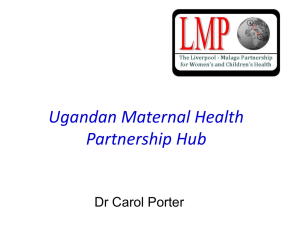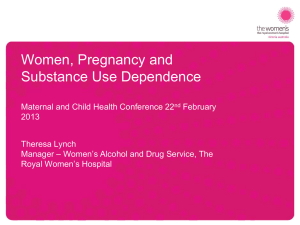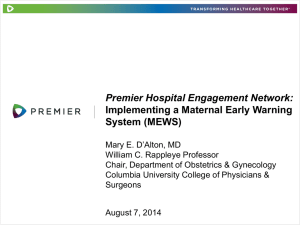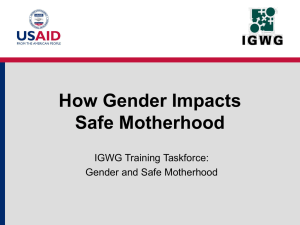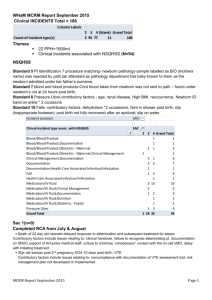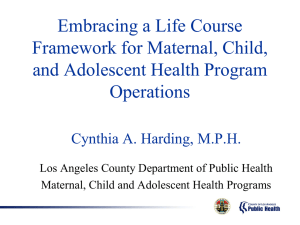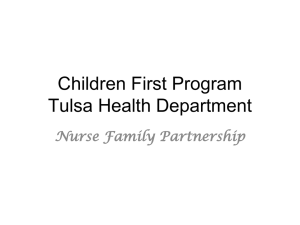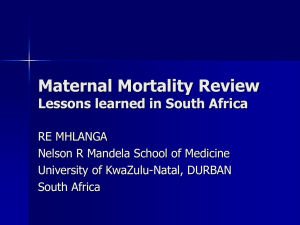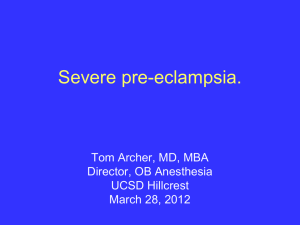OBSTETRIC ANAESTHETIC EMERGENCIES
advertisement
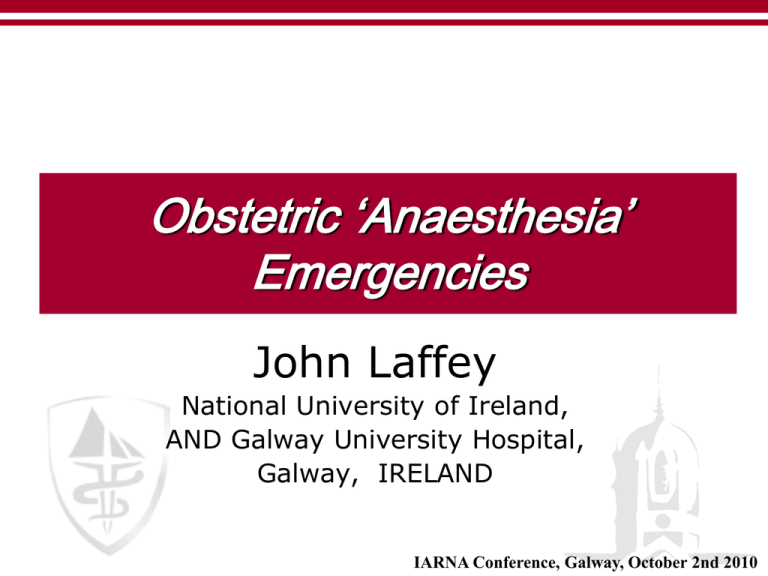
Obstetric ‘Anaesthesia’ Emergencies John Laffey National University of Ireland, AND Galway University Hospital, Galway, IRELAND IARNA Conference, Galway, October 2nd 2010 Key Points • Will focus on Maternal ‘driven’ emergencies – Generally much more difficult situations! • Need to consider 2 patients rather than 1 – A pregnant patient should not be ‘penalised’ • Role of Physiologic Alterations of Pregnancy • Impact of pathologic conditions related to Pregnancy • Delivery of the Foetus may abrogate pregnancy induced conditions • Outcome – Generally Good…. – Obstetric ‘disasters’ every anaesthetists nightmare! Obstetric Critical Care at GUH in 2009 • 30 admissions to ICU/HDU in 2009 • 14 Obstetric Admissions – 4 PPH – 3 PET/HELLP – 7 ‘other’ • 16 Major Gynaecologic Surgery • Average LOS 2.2 days • 2 ICU deaths (both Gynaecologic) Maternal Obstetric Emergencies • Obstetric Haemorrhage • Hypertension/ Pre-Eclampsia • Embolism • Sepsis e.g. Chorioamnionitis • Trauma Physiologic Alterations • Cardiovascular – Heart Rate; Blood Pressure – Blood Volume; Cardiac Output – Venous Circulation; Vascular Resistance – Colloid Osmotic Pressure • Haematologic – – – – • Hb - Decreased by max 2 g/dL Relative Leukocytosis Gestational Thrombocytopaenia Procoagulant State [Fibrinogen; Protein S Pulmonary – Reduced residual lung volume and FRC – Supine Hypoxia • Urinary System – Increased GFR [approaches 150%]; Protein Excretion • Drugs – Decreased serum drug concentration; Serum Albumin Maternal Obstetric Emergencies • Obstetric Haemorrhage • Hypertension/ Pre-Eclampsia • Embolism • Sepsis • Trauma Size of the Problem Size of the Problem • Leading cause of maternal death worldwide • 2 – 55% of deliveries complicated by PPH – Regional variation marked • Characteristically massive and swift – Blood flow to uterus late pregnancy 10% of CO • Haemorrhage may be concealed • Usual signs of hypovolaemia late or disguised Incidence and Causes • Late Pregnancy – Placenta Praevia – Placental Abruption – Spontaneous uterine rupture – DIC e.g. due to Amniotic Fluid Embolism – Trauma • Postpartum – Uterine Atony – Surgical Trauma – Retained Placenta – DIC Disseminated Intravascular Coagulation • Incidence 0.1% of Pregnancies • Causes – Placental Abruption – HELLP syndrome – Intra-uterine Foetal Death – Acute fatty Liver of Pregnancy – Amniotic Fluid Embolism • Clinical Features – Oozing from IV or skin puncture sites, mucosal surfaces, surgical site – Dramatic decrease in Fibrinogen level Management of Massive Haemorrhage • Preparation – Identify patients at risk – Large bore IV access x 3 – Blood available [Type specific; O neg] – Avoid caval obstruction; supplemental O2 – Foetal monitoring, massive bleed change indicative of • Search for evidence of DIC - Peripheral blood smear - PT, PTT, Platelet counts, Fibrinogen level; Ddimer level - ? Specific factor analyses - Bedside coagulation testing (TEG) Volume Replacement • Immediate aggressive volume replacement – Crystalloid until blood available [warming+] • Consider PRBC once blood loss > 2,000mL – Anticipate need early • Unmatched type specific or Type O blood available if required • Dilutional coagulopathy once >80% of blood volume replaced – Platelets - if < 20,000/mm3 or higher if bleeding persisting – FFP only to correct measured clotting abnormalities – Cryoprecipitate Specific Therapies • Uterine atony – Uterine Massage; Oxytocin – Ergometrine [post delivery]; Prostaglandins [Intra-Endometrial] – U/S to detect retained products • Surgical exploration to repair lacerations, ligate arteries, perform hysterectomy • Angiography – Selective embolization of Uterine, internal iliac or internal pudendal artery with slowly absorbable gelatin sponge • Consider prophylactic placement of embolectomy catheters in internal iliac arteries of patients at high PPH risk. • Factor 7a – Rescue therapy in severe haemorrhage Maternal Obstetric Emergencies • Obstetric Haemorrhage • Hypertension/ Pre-Eclampsia • Embolism • Sepsis e.g. Chorioamnionitis • Trauma Size of the Problem • Hypertensive disorders are seen in 12% of pregnancies – 18% of maternal deaths in the US – Predate / Unmasked / Precipitated • Predisposing Factors – Prenatal DM, renal disease, vascular disease – FHx of Hypertension – Primigravid State – Multiple gestational pregnancies • Definition of Hypertension in Pregnancy – Degree of increase in SBP and DBP versus absolute value • ≥30mmHg increase in SPB • 15mmHg increase in DPB • Sustained elevated BP key risk factor Differential Diagnosis • Pregnancy Induced Hypertension – (Gestational Hypertension without Proteinuria) – After 20th gestational week; Longterm risk • Essential Hypertension – Before 20/40; Persists after delivery • Secondary Hypertension – consider if SPB consistently > 200mmHg • Primary Hyperaldosteronism • Cushings Syndrome • Phaeochromocytoma • Renal Artery Stenosis • Coarctation of Aorta • Pre-Eclampsia – Gestational Hypertension with Proteinuria Treatment Recommendations • Perinatal mortality increased if severe sustained Maternal BP elevation – Outcome effect in less severe hypertension less clear – Intra-Uterine Growth Retardation – Caution: Effects on uteroplacental perfusion – Increased maternal mortality and end organ damage • Treatment recommended if SBP ≥ 160mmHg of DBP ≥ 110mmHg – Treat lower BP’s if patient symptomatic • Treatment Options – PO: -methyldopa and Labetalol – IV: Labetalol, Hydralazine, Sodium Nitroprusside Management of a Hypertensive Crisis Clinical Features • SBP generally ≥ 150mmHg; DPB ≥ 110 with • Hypertensive Encephalopathy – Confusion; Papilloedema; Retinal Haemorrhages • Other end-organ dysfunction e.g. Nephropathy, Neuropathy, Retinopathy • Uteroplacental haemorrhage hyperperfusion, placental abruption, • Maternal Catastrophe e.g. Intracranial Haemorrhage • Severe Maternal Hypertension – SBP ≥ 240mmHg; DPB ≥ 140 – ICU management irrespective of presence of clinical sequelae Investigation and Management • Investigations – Bloods incl U+E, Coagulation, CBC, LFT’s – Toxicology – Urinalysis – ECG, CXR; CT Brain • Monitoring – Maternal non-invasive monitoring – Foetal telemetry post viability threshold – Arterial Line + CVC • Treatment Goal – To reduce DBP to just below 100mmHg Therapeutic Strategies – Oral • Labetalol PO – Dose 200-400mg BID -methyldopa – BID/TID to max 4g/d • ACEI’s and AT II Blockers – C/I antepartum • Nifedipine – Rapid effect; increases CI; Uteroplacental flow – 10mg capsule PO, repeat every 15 – 30mins to max 30mg IV Antihypertensives • Labetalol – Rapidly decreases BP (5 mins) but not at expense of Uteroplacental blood flow; no effect foetal HR – Decreases SVR and slows maternal HR • Hydralazine – Direct arterial vasodilator (preferred by Obstetricians) – Care as onset action 10-20 mins; lasts approx 8 hrs – 5 – 10mg boluses every 15-30mins until BP controlled • Na Nitroprusside – Potent, rapid, arterial and venous vasodilator – IV infusion 0.25-0.5mg/Kg/min; max 4mg/Kg/min – S/E’s: Headache, dizziness, flushing, ototoxicity, cyanide toxicity – Foetal Cyanide toxicity not a major issue IV Antihypertensives • Nicardipine – Onset action 10mins; duration 4 – 6hrs – Initial infusion 5mg/hr; increase by 2.5mg/hr every 5min; max 10mg/hr – Potential for NM blockade interaction with Magnesium • Nitroglycerin – Titrate to MAP – Less effective in severe Hypertension • b Blockers – Atenolol [IUGR] – Esmolol [Foetal Bradycardia] Pre-Eclampsia • Incidence – – – – 7% of pregnancies in the US Generally after 32nd week of gestation May initially present after delivery as the HELLP syndrome Primigravida versus older multiparous • Pathogenesis – – – – – – Multi-system disease Endothelial cell injury Placental toxin release Genetic and immunologic factors Generalised vasospasm; ?PG/TX imbalance Microthrombi • Classic Clinical Triad Severe Pre-Eclampsia • Cardiorespiratory – Diastolic dysfunction; LV Failure; Pulmonary Oedema – Increased alveolar-capillary permeability; ALI/ARDS – SBP generally ≥150mmHg; DPB ≥ 110 • Renal – Glomeruloendotheliosis [Proteinuria >5g/d]; – Oliguria; Renal Impairment • Hepatic – Epigastric Pain; ↑Bilirubin; ↑Transaminases – Subcapsular Haematomas; Hepatic Lacerations • Neurologic – Headaches; Visual Disturbances; Focal neurologic deficits – Hyperreflexia ± Clonus; Cerebral Oedema; CNS irritability ± Seizures • Haematologic – Thrombocytopenia; DIC; Haemolysis HELLP • A severe variant of the preeclamptic spectrum of diseases – 0.3% of deliveries – 30% post partum – Syndrome may develop without substantial BP changes • Clinical Features and Diagnosis – Microangiopathic Haemolytic anaemia (H) – Consumptive coagulopathy – Elevated Liver enzymes (EL); Low Platelets (LP) • Presenting Symptoms – Usually non-specific – 20% present with epigastric/RUQ pain, nausea + vomiting • Complications – – – – Acute renal failure; nephrogenic DI ALI/ARDS Haemorrhage incl Liver lacerations, subcapsular haematoma Hypoglycaemia; Hyponatremia • Outcome – Maternal mortality up to 24% in some series – Perinatal mortality 8 – 60% Management of severe Preeclampsia • Early diagnosis; close monitoring; aggressive BP control • Indication for immediate delivery [curative in most cases] • Evidence of cerebral irritability may herald imminent onset of Seizures • Magnesium – Questionable value in mild Preeclampsia – Associated with improved maternal outcome in severe Preeclampsia • Steroids – ? Role for high-dose steroid regimen (dexamethasone 10 mg 12-hourly) Barrileaux et al, Obst Gynecol 2005 Coma / Seizures • Neurologic involvement in 50% of critically ill obstetric patients • Coma – GCS score independent predictor of maternal mortality – Diverse aetiology including Vascular, Infective, Metabolic, Intracranial Mass lesions, Toxic, Preeclampia • Seizures – Commonest cause pre-existing Epilepsy – Presence of hypertension increases likelihood of Preeclampsia – Fulminant Hepatic Failure due to acute fatty liver of Pregnancy • Eclampsia – – – – – Seizures or coma in presence of Preeclampsia or gestational hypertension Potentially lethal phase 50 –75% have occipital/frontal headaches 20-30% visual symptoms Cerebral oedema Coma / Seizure Management • Management – A, B, C – Left lateral position • Increase uterine blood flow • Minimize aspiration risk • Initial Seizure control – Lorazepam / Diazepam – IV MgSO4 • Prevention of recurrent seizures – MgSO4 superior to Phenytoin or diazepam – Initial dose 4 – 6g, plus infusion of 2g/hr – Mg levels after 6hrs (therapeutic level 4 – 8mEq/L) – Check for patellar reflexes; muscle weakness; arrythmias (Ca gluconate) – BP Control Belfort et al NEJM 2003 Maternal Obstetric Emergencies • Obstetric Haemorrhage • Hypertension/ Pre-Eclampsia • Thrombosis/Embolism • Sepsis e.g. Chorioamnionitis • Trauma Venous Thromboembolism • Pregnancy and puerperium a hypercoagulable state • Incidence • Risk Factors • Clinical signs • Investigations – Clinically symptomatic venous TE in 1-2 per 1000 pregnancies – 3 times more common in Postpartum period – Maternal age [>40yrs] – Ethnic and genetic factors – Caesarean section [3 – 16 times increased risk] – ABG, ECG – D-Dimers less useful – Radiographic testing [V/Q scan; CT-PA] • Require less than the 5 rads associated with teratogenesis • Begin therapy immediately if high index of suspicion – Heparin [Fractionated or Unfractionated] versus Warfarin – APTT 2 – 2.5; Anti-Factor Xa 0.6 – 1.1; INR 2.5 – 3 – Continue therapy for 6 – 8 weeks post delivery Amniotic Fluid Embolism • Catastrophic complication – 1 case per 8,000-30,000 pregnancies in US – amniotic fluid, fetal cells, hair, or other debris enter maternal circulation – Usually occurs in Labour; Trauma; Abortion – possible anaphylactic reaction to fetal antigens • Clinical Features – Severe respiratory distress; ALI/ARDS – Cardivascular collapse – DIC – may be major clinical manifestation • Treatment is supportive – Emergent C/S in unresponsive Cardiac Arrest [5min CPR] • Outcome – Mortality 60 to 80% – Most survivors have permanent neurologic impairment. – Neonatal survival is 70%. – No evidence increased AFE risk in future pregnancies. Maternal Obstetric Emergencies • Obstetric Haemorrhage • Hypertension/ Pre-Eclampsia • Embolism • Sepsis e.g. Chorioamnionitis • Trauma Epidemiology • Most common non-obstetric cause of Maternal Death – 46% of deaths among pregnant women in one US series – 57% homicides; 9% suicides; 21% RTA’s • Patterns and mechanisms of injury same as in nongravid patients • Causes of Maternal Death from Trauma – Head Injury – Haemorrhage • Causes of Foetal death from Trauma – Placental abruption [shear forces] – Head injury [Pelvic fracture] – Compromised Uteroplacental Circulation Management Principles - I • Optimal management of Mother is best for Foetus • Initial assessment and resuscitation should follow standard protocols – U/S; FAST; DPL • Targeted Radiographic studies – Uterine shielding where possible – Highest foetal risk at 8 – 15/40 – Exposure less than 1RAD low risk – Plain x-ray 0.2 RAD; CT 0.5RAD per slice • Avoid supine Hypotension Syndrome [Left Lateral tilt] • Foetal monitoring and Obstetric consultation once foetus potentially viable Specific Pregnancy Complications • Foetomaternal Haemorrhage – 1 in 4 gravid Trauma pts – Kleihauer test • Abruptio Placentae • Amniotic Fluid Embolism • Premature Labour • Uterine rupture • Foetal Demise • Cardiac Arrest – Standard algorithms initially+ CPR – Consider open cardiac massage – Caesarean section Summary • Pregnancy is not a disease state! • Obstetric emergencies not infrequent – May be associated with serious morbidity • Potential for conflict in regard to Mother vs Foetus overstated • Physiologic Alterations of Pregnancy may play role • Early recognition and decisive intervention Paramount – Need for close cooperation with Obstetric Team – Multi-disciplinary Effort required, incorporating • Anaesthesia Team • Obstetric team • Nurses and Doctors • Outcome – Depends on specific Problem – Generally good when recognised early and managed appropriately Questions
